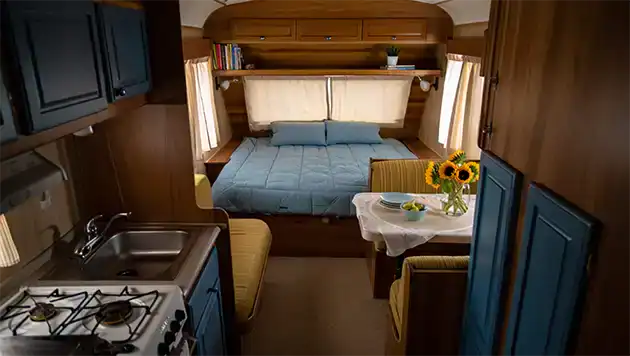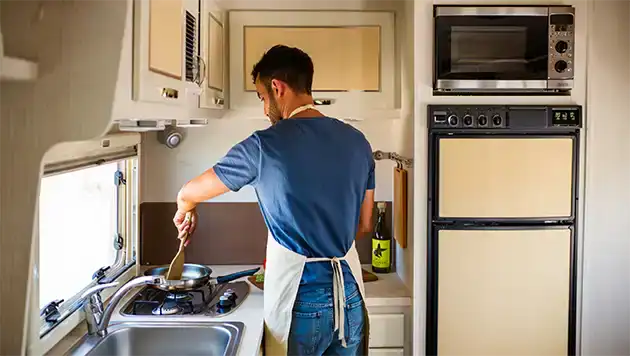
Thank you for reading our post, please rate this article at the end.
Reading Time: 12 minutesLast Updated on October 9, 2025 by Paul Clayton
Table of Contents
Living Small: Simplifying Your RV Life
Key Takeaways
-
- Mindset Shift is Key: Successfully living small in an RV requires adopting a minimalist mindset that views limited space as an opportunity to prioritize needs and focus on what truly adds value to daily life.
- Prioritize Experiences over Possessions: The core benefit of simplifying is gaining freedom and flexibility by intentionally shifting value from material goods to memorable experiences, travel, and deeper human connections.
- Financial and Mental Gains: A decluttered RV leads to tangible benefits, including lower expenses (freeing funds for travel) and greater mental clarity due to reduced stress and easier cleaning routines.
- Digital Preservation: Overcoming emotional attachments to sentimental items is necessary and can be achieved by digitizing photos, documents, and books, preserving memories without occupying physical storage space.
Living in an RV often means learning how to do more with less. When space is limited, every item, habit, and choice matters. The key to simplifying RV life is adopting a minimalist mindset and focusing on what truly adds value to daily living. By making thoughtful adjustments, we can create a lifestyle that feels less cluttered and more functional.
We know the transition can feel overwhelming at first. Downsizing forces us to decide what stays, what goes, and how to make the most of every square inch. With smart storage solutions, multi-functional tools, and daily habits that keep things organized, small spaces can feel surprisingly comfortable.
This approach is not about giving things up—it’s about gaining freedom. By simplifying, we free ourselves from unnecessary stress and open the door to more flexibility, comfort, and ease on the road. Our journey ahead will explore how to embrace minimalism, maximize storage, and choose tools that make RV life both simple and enjoyable.
- Today’s Best Pop-Up Campers
- New vs. Used RV: Navigating the Price Trends
- Can You Rent an RV for a Year?
Embracing the Minimalist Mindset
Adopting a minimalist mindset in RV life helps us create more space, reduce stress, and focus on what truly matters. By letting go of excess, we gain the freedom to enjoy our daily routines, new experiences, and deeper connections while living simply.
Benefits of Minimalism in RV Living
When we simplify our RV lifestyle, we notice immediate benefits. A smaller wardrobe, fewer kitchen tools, and only essential gadgets mean less clutter and easier cleaning. This makes our tiny living space feel more open and functional.
Minimalism also saves money. By buying less, we reduce our expenses and free up funds for essential items like fuel, campground stays, or repairs. Many RVers discover that this financial shift allows more flexibility in travel and long-term planning.
The mental benefits are just as important. A decluttered space often leads to a calmer mindset. We spend less time organizing and more time enjoying the road. As one guide on downsizing for RV living explains, reducing possessions creates a more comfortable and functional home on wheels.
Key benefits:
- Less clutter and easier cleaning
- Lower expenses and financial freedom
- Greater mental clarity and reduced stress
Shifting Priorities from Possessions to Experiences
Living small in an RV encourages us to rethink what we value. Instead of filling shelves with objects, we prioritize experiences like hiking trails, meeting fellow travelers, or exploring new towns.
This shift doesn’t happen overnight. At first, we may feel the urge to hold on to things “just in case.” Over time, we come to realize that memories from trips and connections with people matter more than items stored in bins.
We can also see how this lifestyle aligns with sustainability. Choosing fewer possessions reduces waste and energy use. As minimalist RV strategies highlight, focusing on quality over quantity helps us live more intentionally while still enjoying comfort on the road.
By valuing experiences, we give ourselves the freedom to move often, spend time outdoors, and make each stop meaningful.
Overcoming Emotional Attachments
One of the most challenging aspects of adopting a minimalist mindset is letting go of items tied to cherished memories. Many of us keep souvenirs, old clothes, or family heirlooms that don’t fit well in a tiny living space.
We can approach this challenge by keeping only what has true sentimental value. For example, instead of holding on to a box of mementos, we might choose one small item that represents the memory. Digital photos also help preserve moments without taking up space.
It helps to ask questions: Do we use this regularly? Does it serve a purpose in our RV life? If the answer is no, it may be time to let it go.
As explained in guides on minimalist RV living, the goal isn’t to give up everything but to choose what supports our lifestyle. By overcoming emotional attachments, we create room for what truly matters—both physically in our RV and mentally in our daily lives.
Downsizing for RV Life
When preparing for RV living, we need to reduce our possessions, make informed decisions about what to keep, and create space for what truly supports daily life on the road. This process helps us simplify, stay organized, and avoid carrying unnecessary weight or clutter.
Effective Strategies for Decluttering
We start by setting clear goals for downsizing. Knowing how much space we have in the RV helps us decide what fits and what doesn’t. A 40-foot motorhome has different storage than a small travel trailer, so our choices must match the actual space available.
One practical method is the “one in, one out” rule. If we bring something new, we remove something else. This keeps clutter from building up.
We also use a step-by-step approach. Tackling one room or category at a time makes the process less overwhelming. For example, we might begin with clothing before moving on to kitchen items.
Another useful strategy is digitizing. Important papers, photos, and even books can be stored digitally, saving space while still keeping access. This keeps storage cabinets free for essentials.
Sorting and Categorizing Belongings
When downsizing, sorting items into clear categories helps us make decisions more quickly. We often use four main categories: Keep, Donate, Sell, and Trash. This simple framework makes the process more structured.
- Keep: Items we use daily or that serve multiple purposes.
- Donate: Gently used items that can help others.
- Sell: Furniture, appliances, or gear that still has value.
- Trash: Broken, outdated, or unnecessary items.
We also consider item size and weight. Heavy or bulky things may not be practical for RV storage. Selling large pieces, such as couches or dining tables, often makes sense, and platforms like Facebook Marketplace make it easy to connect with buyers.
By following a clear sorting system, we avoid second-guessing and keep the process moving forward.
Letting Go with Purpose
Part of downsizing is dealing with sentimental items. We may feel attached, but RV living requires tough choices. We can keep a few small keepsakes while letting go of the rest.
One helpful method is choosing items that represent memories instead of keeping everything. For example, a single photo album can replace boxes of old pictures.
We can also scan photos and documents to preserve them digitally. This way, we still carry the memories without filling storage bins.
Letting go becomes easier when we focus on the benefits. A lighter RV, lower storage costs, and less clutter all mean more freedom to enjoy the lifestyle. Downsizing with intention helps us create a home that feels comfortable and uncluttered.
Maximizing Storage Space Efficiently
We can maximize the use of limited storage space by selecting tools and layouts that meet our daily needs. Simple changes, such as adding hooks, dividers, or hidden compartments, help us stay organized and reduce clutter in small spaces.
Creative Storage Solutions
We often find that the simplest tools create the biggest impact. Command hooks let us hang hats, utensils, or even lightweight bags without drilling holes. Over-the-door organizers are ideal for storing shoes, cleaning supplies, or toiletries.
Using nesting containers is another smart choice. They stack neatly when not in use, saving space while still giving us flexible storage. For small items like jewelry, screws, or sewing supplies, a tackle box or divided case keeps everything visible and easy to grab.
Multi-purpose furniture, such as ottomans with hidden compartments, allows us to store blankets or games without occupying extra floor space. When we choose items that serve multiple functions, we reduce clutter and free up valuable space.
Utilizing Vertical and Hidden Spaces
Walls, ceilings, and the space under furniture often go unused. Adding magnetic strips under cabinets or along walls provides a convenient place to store knives, scissors, or even spice tins. This keeps counters clear and items within reach.
We can also install vertical shelving in areas like closets or pantries. Even a small wire shelf doubles the usable area, making it easier to separate and organize items. In the kitchen, hanging mugs or utensils under shelves creates more open cabinet space.
Hidden storage is just as useful. Under-bed compartments or bins beneath couches hold extra clothes, bedding, or seasonal gear. Rolling clothes and storing them in mesh bags keeps them compact and breathable. These hidden areas help us keep the main living space clutter-free.
Organizing Cabinets and Drawers
Cabinets and drawers can easily become messy if we don’t separate items. Drawer dividers keep utensils, tools, or toiletries from shifting around during travel. Clear bins or labeled containers make it easy to see what we have without having to dig through piles.
In the refrigerator, small plastic bins prevent food from sliding and spilling. Collapsible containers are also helpful since they shrink down when empty. For dry goods, stackable canisters maximize vertical space and keep food fresh.
A simple labeling system adds another layer of efficiency. By marking bins and shelves, we know exactly where each item belongs. This saves time and prevents overcrowding, which is key when we’re working with limited storage space in an RV.
For more ideas, we can explore RV space-saving hacks that show practical ways to make every inch count.
Choosing Multi-Functional Furniture and Tools
When we live in an RV, every inch matters. Selecting items that serve multiple purposes helps us stay organized, reduce clutter, and maximize the use of limited space. Smart furniture, practical gadgets, and digital tools can transform a small living space into a more comfortable and efficient lifestyle.
Selecting Space-Saving Furniture
Multi-functional furniture is one of the best ways to maximize space. A sofa bed provides seating during the day and converts to a bed at night, while a storage ottoman serves as both seating and a hidden storage space. Expandable dining tables let us adjust for two people or a small group without wasting space.
Some of the most effective pieces include:
- Murphy beds that fold into the wall.
- Nesting tables that tuck away when not in use.
- Wall-mounted desks create a workspace without taking up floor space.
Options like these are especially useful in RV living because they reduce clutter and maintain a flexible layout. For more examples, consider multifunctional furniture ideas for small spaces.
Investing in Essential Gadgets
Compact, multi-use gadgets help us reduce bulk. A pressure cooker that also works as a slow cooker and rice cooker eliminates the need for separate appliances. A cordless vacuum that converts into a handheld unit makes cleaning easier, eliminating the need to store multiple tools.
We should also look for collapsible kitchenware, such as silicone bowls, foldable kettles, and stackable cookware. These items save cabinet space and are lightweight, which is important for managing RV weight limits.
When choosing gadgets, durability and power efficiency are key considerations. Relying on tools that use less electricity or can charge via USB helps us conserve energy, especially when we are off-grid.
Adopting Digital Alternatives
Digital tools reduce the need for physical storage. Instead of carrying shelves of books, we can use an e-reader to hold hundreds of titles in one slim device. Streaming music and movies also replace stacks of DVDs and CDs, freeing up valuable cabinet space.
We can digitize paperwork by scanning receipts, manuals, and documents, then storing them in cloud services. This not only saves space but also keeps important files backed up and accessible anywhere.
Even entertainment for kids can be simplified with tablets that store games, audiobooks, and educational apps. By adopting these alternatives, we reduce clutter and keep our RV organized.
Daily Habits for Maintaining a Simplified RV Life
Living in a small space, such as an RV, requires establishing steady routines that keep clutter under control and make daily tasks easier. By focusing on organization, mindful shopping, and maintaining clear surfaces, we create a more functional environment that supports stress-free travel and small-space living.
Routine Organization Practices
We benefit most when we set aside a few minutes each day to put things back where they belong. This prevents piles from forming and saves time in the long run. Using small baskets, drawer dividers, and labeled containers helps us return items quickly without having to search.
A simple checklist can guide us:
- Morning: Make the bed, wipe counters, return loose items.
- Afternoon: Tidy the kitchen, check the trash, and reset the workspace.
- Evening: Put away clothes, set out tomorrow’s essentials.
These small steps keep our RV functional without requiring a full cleaning session. We also utilize vertical storage and wall hooks to ensure that daily-use items, such as jackets or keys, have a designated spot. Consistency is what makes the system work, even when moving home.
Managing Accumulation and Purchases
In RV life, every new item takes up space and adds weight. To stay ahead, we follow a one-in-one-out rule. If we buy a new pan, we let go of the old one. This habit prevents the slow buildup of unused gear.
We also pause before buying. Waiting 24–48 hours helps us decide if something is truly needed. Many people living in small spaces find success with intentional shopping lists that focus only on essentials.
When possible, we opt for multi-purpose items, such as collapsible bowls, reversible clothing, or storage ottomans. These reduce the number of things we carry while still meeting our needs. Following habits like these, as explained in minimalist RV living strategies, makes our space easier to manage.
Keeping Surfaces Clear
Clear counters and tables make a small RV feel larger and more spacious. We avoid letting mail, tools, or dishes sit out. Instead, we assign a drawer or bin for each type of item so surfaces stay open.
We also set a rule: no more than two items can live on a counter—usually a coffee maker and a fruit basket. Everything else must have a storage spot.
At night, we perform a quick reset by wiping down tables and putting away any items left out. This habit ensures we wake up to a clutter-free space. Clean surfaces not only improve function but also reduce stress, which is crucial in small-space living.
Enhancing Comfort and Functionality in Small Spaces
When we live in a compact RV, every square foot matters. Comfort depends on how well we manage storage space, create flexible layouts, and select furniture or fixtures that serve multiple purposes. Small changes in design can make daily routines easier and help us enjoy tiny living without feeling cramped.
Designing Multi-Purpose Living Areas
We can make our RV lifestyle more efficient by selecting furniture that accommodates various needs. A sofa bed with built-in storage provides seating during the day and a bed at night while also holding blankets or clothes. Fold-down tables or wall-mounted desks give us work or dining space that disappears when not in use.
Using room dividers, such as curtains or shelving, helps us separate zones without closing off the area. For example, a tall but narrow bookcase can serve as both a storage space for supplies and a visual divider between the living and sleeping areas. This keeps the space open but organized.
We should also take advantage of vertical storage. Installing overhead cabinets or hanging baskets utilizes wall height, freeing up floor space for movement. These small adjustments allow one area to serve multiple functions without feeling cluttered.
Optimizing Sleeping and Kitchen Zones
Sleeping and cooking areas are the most used in an RV, so they need careful planning. Beds with drawers underneath or lift-up platforms provide hidden storage for clothes or seasonal items. In smaller rigs, a Murphy bed can fold into the wall, leaving open space for daytime activities.
In the kitchen, compact appliances and collapsible cookware save space. We can also mount magnetic strips for knives or utensils, freeing drawers for other items. Installing pull-out pantry racks in narrow gaps makes food storage more efficient.
Simple upgrades, such as LED strip lighting under cabinets, improve visibility without occupying space. By combining smart storage with scaled-down essentials, we keep both the kitchen and sleeping zones functional and comfortable, even in tight quarters.
For more ideas on maximizing comfort in limited areas, consider designing for small spaces, as this offers practical strategies well-suited to RV living.
 Frequently Asked Questions
Frequently Asked Questions
We focus on selecting the right essentials, maintaining a well-organized space, and adopting habits that make RV life more efficient. Regular upkeep and thoughtful choices also help us stay comfortable, safe, and environmentally mindful.
What are the essential items needed for a comfortable RV lifestyle?
We need a reliable power source, safe drinking water, and climate control to maintain our comfort. Cooking gear, compact furniture, and bedding that fit our space also make daily life easier. A basic toolkit and a first aid kit are essential for safety and quick fixes.
How can I maximize space in a small RV?
We utilize vertical storage with shelves, hooks, and hanging organizers. Multipurpose furniture, such as ottomans with storage or foldable tables, helps save space. Clear bins and labels keep items easy to find without wasting space.
What strategies exist for reducing personal belongings to fit into an RV?
We sort items into four piles: keep, donate, sell, and discard, to simplify our decisions. Using methods like the KonMari approach helps us decide what truly adds value. Starting months in advance gives us time to downsize without feeling rushed, as noted in this guide for downsizing for full-time RV living.
What are the best practices for maintaining an organized and clutter-free RV?
We store items in designated spots and return them after use. Rolling clothes, using vacuum bags, and minimizing duplicates reduce clutter. Regularly reviewing our belongings ensures we only keep what we actually use.
How often should I perform maintenance checks on my RV to ensure a simplified living experience?
We check tire pressure, fluid levels, and battery health before each trip. Monthly inspections of plumbing, seals, and appliances help prevent larger issues. Seasonal deep checks on the roof, brakes, and electrical system keep the RV safe and reliable.
What tips can you offer for creating a sustainable and eco-friendly RV living environment?
We reduce waste by using reusable dishes and water bottles. Solar panels and LED lights lower energy use and extend off-grid time. Choosing eco-friendly cleaning products and conserving water also support a lighter footprint, as suggested in minimalist RV living strategies.
Final Thoughts
Use clear categories (Keep, Donate, Sell, Trash) and apply the “one in, one out” rule continuously to prevent the gradual accumulation of clutter after the initial move. Utilize vertical and hidden storage by installing simple solutions like Command hooks, magnetic strips, and over-the-door organizers to keep counters clear and functional.
Choose essential items that serve multiple purposes, such as collapsible kitchenware, multi-use appliances (e.g., pressure cookers), and furniture that doubles as storage (storage ottomans, sofa beds). Maintain organization by establishing short, consistent daily routines (e.g., five minutes of tidying) to put things back in their designated spots, which is critical in a small living space.
Always pause and assess before buying new items, opting for durable, lightweight, and multi-purpose tools that directly support a simplified, clutter-free lifestyle.








